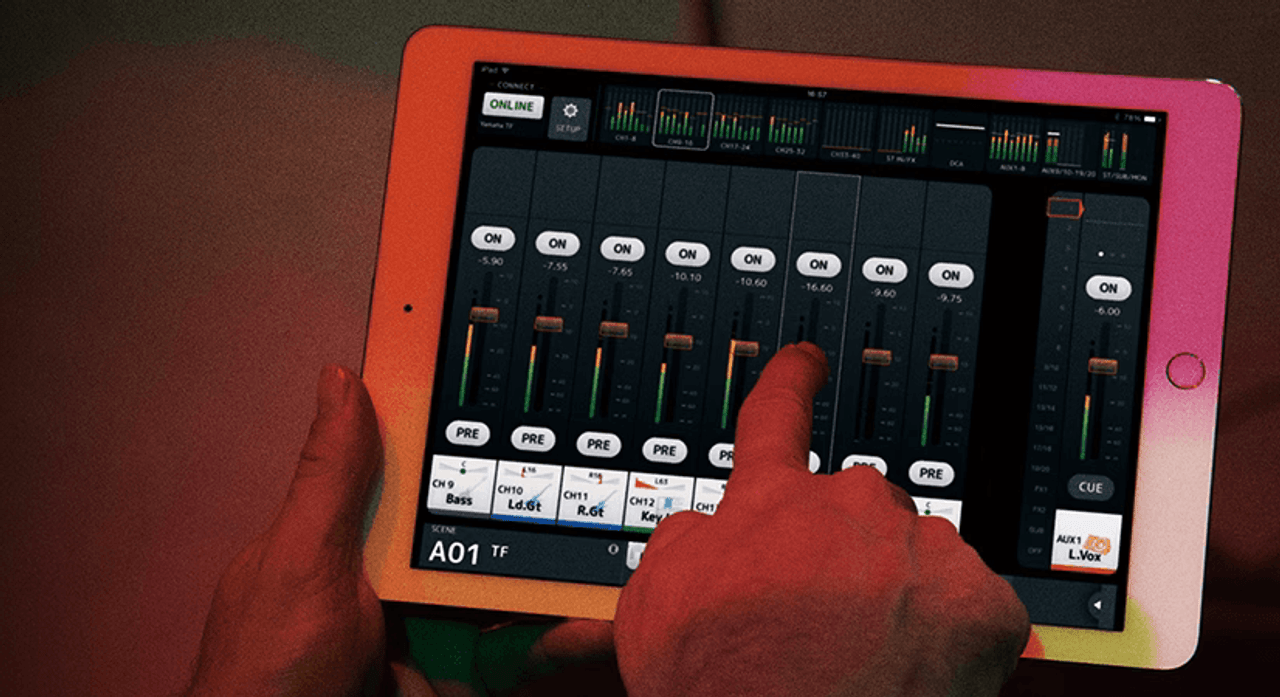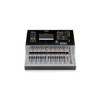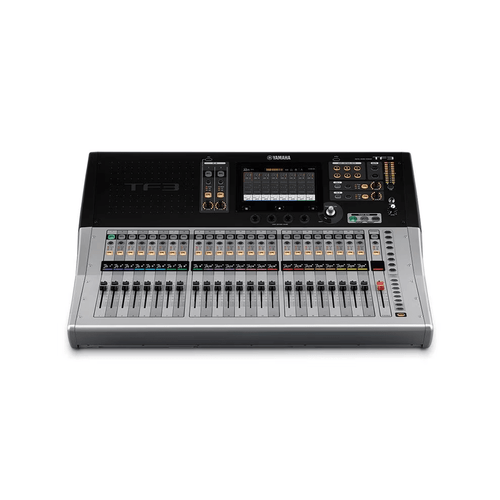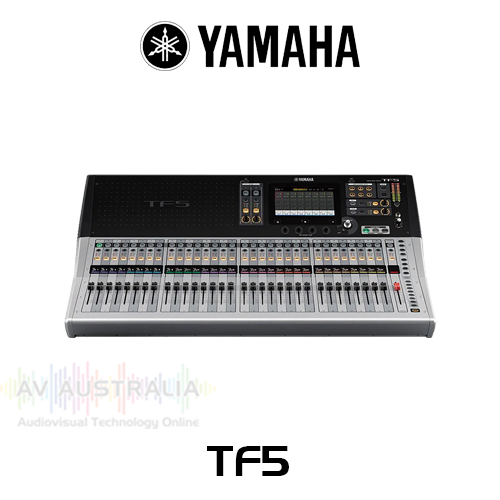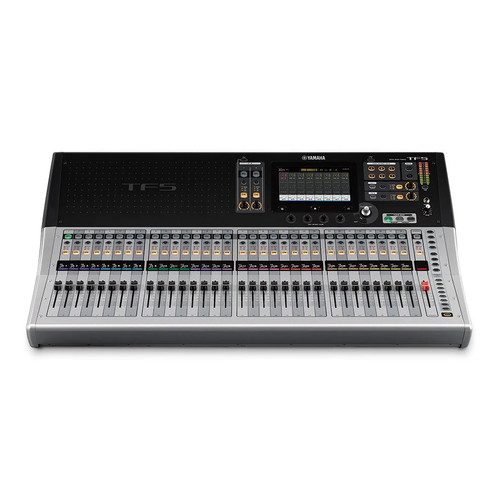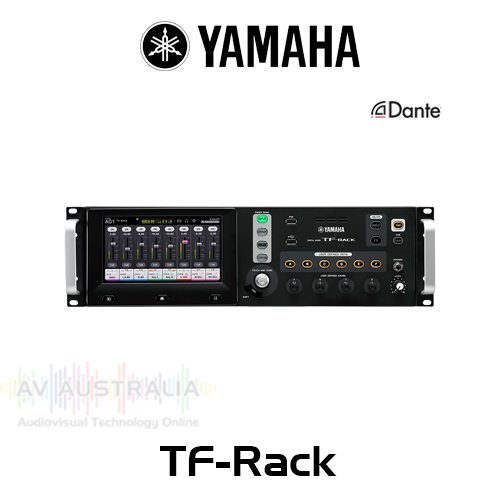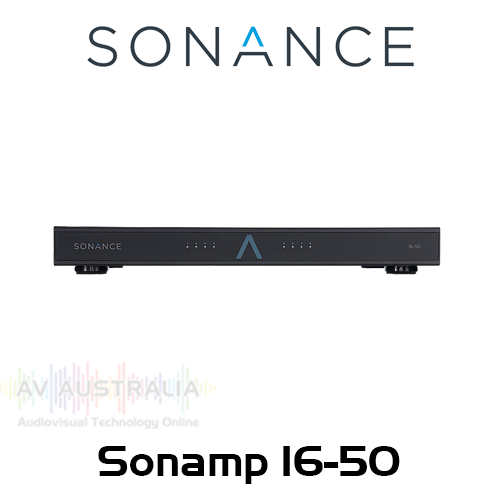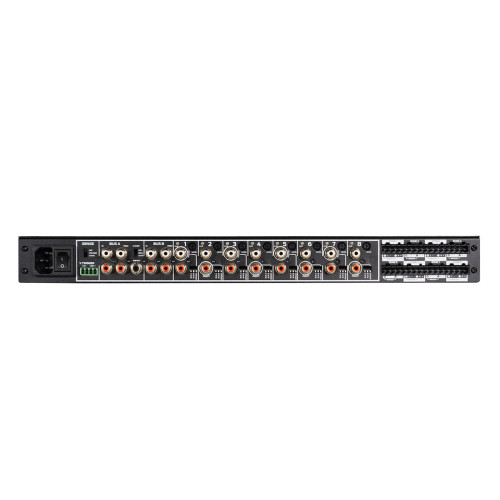Product Description
Key Features
• 17 motor faders (16 channels + 1 master)
• 20 Aux buses (8 mono + 6 stereo) + Stereo + Sub
• 8 DCA groups with Roll-out
• 16 analog XLR outputs
• 8 Effects and 10 GEQ
• 1 expansion slot for NY64-D audio interface card
• 40 input mixing channels (32 mono + 2 stereo + 2 return)
• 16 analog XLR/TRS combo mic/line inputs + 2 analog RCA pin stereo line inputs
• 34 x 34 digital record/playback channels via USB 2.0 + 2 x 2 via a USB storage device
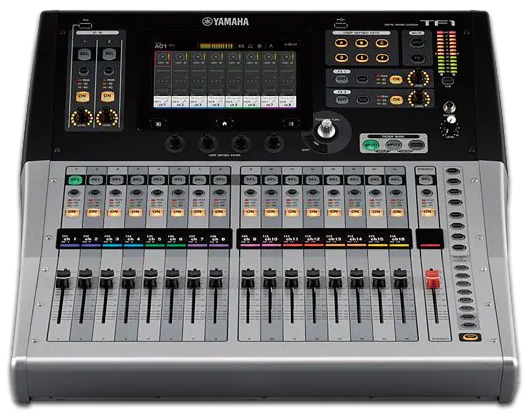
Intuitive User Interface Optimized for Touch Panel Operation
In developing the TF series Yamaha engineers built from their existing base of acclaimed high-end mixer interfaces, adding intuitive control in an interface optimized for the type of touch panel control that has become a familiar feature in a wide range of applications. Allowing most operations to be carried out via the touch panel alone, the innovative TF series interface will quickly become second nature to a broad spectrum of users. Whether you have experience with Yamaha digital consoles, work with other digital consoles, operate analog consoles, or have never operated a mixer before, TF consoles will lead you to the desired results quickly and effortlessly through a smooth, efficient workflow. The availability of physical controls surrounding the touch panel further enhances control versatility and precision.
Touch Operation for Intimate Control
Refined for the smoothest possible operation via touch-panel control, the TF user interface offers a smooth workflow that can be an advantage in any mixing situation. The display content has been specifically designed for easy, direct accessibility, with a layout that promotes the most natural, efficient mixing. Touch panel operation is as easy as shaping the sound with your fingertips.

Touch & Turn Knob Offers Extra Control PrecisionWhen you need extra precision for a fine EQ or other adjustment, the physical Touch & Turn knob is always available right beside the touch panel. There are also four User Defined Knobs below the panel that can be assigned to control compressor threshold, EQ gain, or other parameters you need fast, direct access to while mixing. The knobs always affect the currently selected channel. |
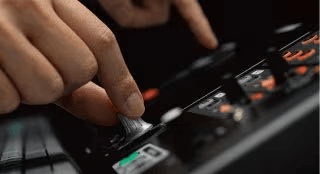 |
|
Traditional Overview and Selected Channel InterfacesLike the CL series consoles, operation is based around Overview and Selected Channel windows. The overview display shows the parameters for eight channels at a time, while the Touch & Turn knob provides direct access to gain, 1-knob EQ™, 1-knob COMP™, gate threshold, effect send level, pan, and other parameters. Touch the highlighted parameter a second time to switch to the Selected Channel display when you need access to detailed parameters for finer control. |
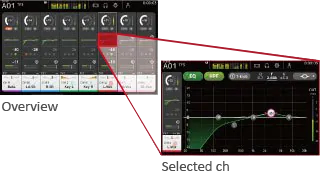 |
New Features for Smooth Setup and Operation
Effective gain, compressor, and EQ setup requires a considerable degree of skill and experience. Even veteran engineers need to spend time on these important basic settings. In addition to their intuitive user interfaces, TF consoles include a number of features that contribute to faster, smoother setup of these essential parameters.
1-knob COMP™ & 1-knob EQ™: One Knob to Dial In the Ideal SoundAn experienced engineer can do a lot with a compressor: bring a guitar to life, add punch to bass, tighten up a snare, and make vocals ride clearly on the mix. The 1-knob COMP can do all of this quickly and easily, without the need to juggle multiple parameters to achieve the desired effect. Originally introduced in Yamaha analog mixers, the 1-knob COMP quickly became a popular and valued feature. It has now been further refined in a digital version that adds new setup ease and efficiency to the TF consoles. The same concept has been applied in a new 1-knob EQ feature that provides notably improved speed and smooth operation. 1-knob EQ has been painstakingly fine-tuned by Yamaha R&D staff in cooperation with distinguished sound engineers, to ensure that you can achieve outstanding results with minimum effort in the shortest possible time. A Vocal Mode makes it easier than ever to achieve a clear, well defined vocal sound, while an Intensity Mode offers 1-knob “intensity” control over EQ curves you either select from the presets or create from scratch.But there’s more: the 1-knob COMP and 1-knob EQ are provided on the output channels too, so you can quickly achieve overall output compression or EQ that ideally matches the room and audience size. The output 1-knob EQ has a Loudness Mode in place of the Vocal Mode, effectively increasing the sound pressure level while maintaining optimum sound as you rotate the knob. Both the 1-knob COMP and 1-knob EQ provide quick access to the full compressor and EQ displays, so you can fine tune settings as required. |
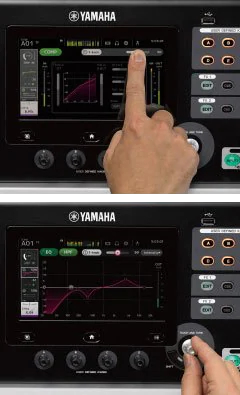 |
|
GainFinder™ Supports Precision Gain SetupGain is the first adjustment the input signal sees, and the way it is set up influences how subsequent parameters will affect the signal. Yamaha has developed a way to make fast, accurate setup of this important basic parameter easier than ever. The new GainFinder feature facilitates optimum gain setup for individual input signals so that ideal overall operation and signal quality is achieved. The user only has to set channel gain so that the central green indicator in the level meter remains lit for the longest possible time. Of course the level meters also perform their traditional function, so standard gain setup procedure can be followed if preferred. |
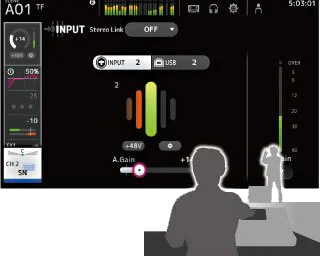 |
Practical Presets and Scenes – Shortcuts to Great Sound
The familiar Yamaha scene memory that stores mix settings for instant recall when needed is included as always. There’s also a range of channel presets that have been created in cooperation with leading microphone manufacturers and eminent sound engineers, providing starting points that take you a long way towards achieving great sound. The channel presets cover parameters such as HA gain, EQ, dynamics, and much more, right down to details like channel name and color. Less time needs to be spent on basic setup so that more time is available for refining the mix and communicating with the performers.
Design for Superior Visibility and Quick Operation
The TF series hardware is packed with features that contribute to superior operability and convenience. Faders, knobs, and buttons with outstanding fit and feel work seamlessly with state-of-the-art display technology, including high-visibility channel name and color displays. The touch panel itself offers an ideal blend of comprehensive visual feedback and fast response.The physical layout of these components brings everything together in a system that offers surprisingly efficient workflow.
Other Features for Efficient Workflow
- USER DEFINED KNOBS section: Frequently used parameters such as compressor threshold and EQ gain, for example, can be assigned for direct, instant access when needed.
- USER DEFINED KEYS section: Assign mixer settings that you use often to these six buttons for instant access, such as direct one-touch recall of specified scenes.
- MUTE section: Multiple inputs or effects can be muted with a single operation.
- FX section: A dedicated channel offers easy effect ON/OFF switching, cue monitor ON/OFF switching, level adjustment, and effect parameter editing.
- ST IN section: In addition to allowing digital playback from an iPad or iPhone or recording/playback with a USB device, you have fingertip control of BGM playback and other audio files.* When using a USB storage device for recording, use a hard disk drive or other high-speed device. (USB memory drives are not guaranteed to function properly.)
Specifications
| TF5 | TF3 | TF1 | TF-Rack | ||
Outline |
|||||
| Fader Configuration | 32 + 1 (Master) | 24 + 1 (Master) | 16 + 1 (Master) | - | |
| Mixing Capacity | Input Channels | 48 (40 mono + 2 stereo + 2 return) | 40 (32 mono + 2 stereo + 2 return) | ||
| Aux Buses | 20 (8 mono + 6 stereo) | ||||
| Stereo Buses | 1 | ||||
| Sub Buses | 1 | ||||
| Input channel functions | 8 DCA Groups | ||||
| I/O | Inputs | 32 mic/line (XLR/TRS combo) + 2 stereo line (RCA pin) | 24 mic/line (XLR/TRS combo) + 2 stereo line (RCA pin) | 16 mic/line (XLR/TRS combo) + 2 stereo line (RCA pin) | 16 mic/line (XLR/TRS combo) + 1 stereo line (RCA pin) |
| Outputs | 16 (XLR) | 16 (8 XLR + 8 TRS phone) | |||
| Expansion slots | 1 | 1 (for NY64-D) | |||
| On-board processors | DSP | 8 Effects + 10 GEQ | |||
General specifications |
|||||
| Sampling frequency rate | Internal | 48 kHz | |||
| Signal delay | Less than 2.6 ms, INPUT to OMNI OUT, Fs=48 kHz | ||||
| Fader | 100 mm motorized, Resolution = 10-bit, +10 dB to –138 dB, –∞ dB all faders | Resolution = 10-bit, +10 dB to –138 dB, –∞ dB all faders | |||
| Total harmonic distortion | Less than 0.05% 20 Hz–20 kHz @+4 dBu into 600 Ω , INPUT to OMNI OUT, Input Gain=Min. (Measured with a –18 dB/octave filter@80 kHz) | Less than 0.05% 20 Hz–20 kHz @+4 dBu into 600 Ω, INPUT to OMNI OUT, Input Gain=Min. (Measured with a –18 dB/octave filter@80 kHz) | |||
| Frequency response | +0.5, –1.5 dB 20 Hz–20 kHz, refer to +4 dBu output @1kHz, INPUT to OMNI OUT | ||||
| Dynamic range | 110 dB typ., DA Converter, 107 dB typ., INPUT to OMNI OUT, Input Gain=Min. | 110 dB typ., DA Converter, 108 dB typ., INPUT to OMNI OUT, Input Gain=Min. | |||
| Hum & noise level | Equivalent input noise | –128 dBu typ., Input Gain=Max. (Measured with an A-Weight filter) | |||
| Residual output noise | –85 dBu, ST master off (Measured with an A-Weight filter) | ||||
| Crosstalk | –100 dB (Measured with a –30 dB/octave filter@22 kHz), adjacent INPUT/OMNI OUT channels, Input Gain=Min. | ||||
| Power requirements | 100–240 V 50/60 Hz | ||||
| Power consumption | 120 W | 110 W | 100 W | 85 W | |
| Dimensions | W | 866 mm (34.1in) | 716 mm (28.2in) | 510 mm (20.1in) | 480 mm (18-7/8 in) |
| H | 225 mm (8.9in) | 132 mm (5-1/4 in) | |||
| D | 599 mm (23.6in) | 409 mm (16-1/8 in) | |||
| Net weight | 20.0 kg (44.1lb) | 17.0 kg (37.5lb) | 13.5 kg (29.8lb) | 9.2 kg (20.3lb) | |
| Options | Expansion Card, Foot Switch (FC5) | Rack-mount Kit RK5014, Expansion Card, Foot Switch (FC5) | Audio Interface Card (NY-64D), Foot Switch (FC5) | ||
| Others | Operating temperature range: 0–40 °C, Storage temperature range: -20–60 °C | ||||
What's In The Box
- Main unit
- AC power cord
- Quick Guide
- Nuendo Live (DAW software)




